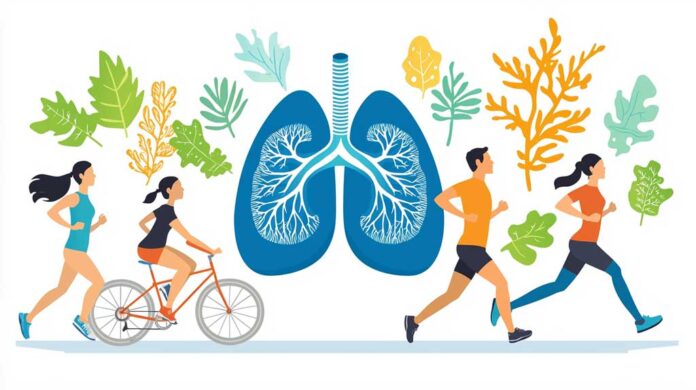Exercise training for respiratory health represents an evidence-based approach to transforming chronic respiratory disease management, affecting hundreds of millions worldwide.
These conditions, including chronic obstructive pulmonary disease (COPD) and asthma, significantly impact quality of life and contribute to substantial mortality rates globally.
The scale of this health challenge is striking. According to recent data, asthma affects an estimated 262 million people worldwide, while COPD claims over 3.23 million lives annually. Moreover, these conditions disproportionately affect low- and middle-income countries, where underdiagnosis and limited treatment access remain significant challenges.
Structured exercise training for respiratory health can substantially improve respiratory function and overall health outcomes. Physical activity helps enhance ventilatory efficiency, strengthen respiratory muscles, and improve cardiovascular fitness. These adaptations are particularly crucial as respiratory conditions often lead to a cycle of reduced activity and further deconditioning.
Exercise benefits respiratory health through multiple pathways. From improving mucus clearance to enhancing respiratory muscle strength, physical training offers a comprehensive approach to managing respiratory conditions.
Exercise training’s ability to reduce systemic inflammation and improve skeletal muscle function is a pillar of respiratory rehabilitation programmes.
The difficulty of respiratory conditions demands varying approaches to exercise implementation. Each respiratory condition responds differently to specific training methods, from continuous aerobic activities to interval protocols, resistance training, and specialised breathing exercises.
This post covers a detailed analysis of how respiratory conditions impact exercise capacity, practical ways to implement effective training programmes, vital safety measures, monitoring protocols, and specific exercise recommendations and adaptations for various respiratory conditions. Thus, it offers valuable insights for optimising physical activity approaches.
Understanding Exercise Limitations in Respiratory Conditions
Respiratory conditions fundamentally alter how the body responds to physical activity, with exercise training for respiratory health requiring careful consideration of these physiological limitations. Ventilatory constraints manifest through multiple mechanisms that restrict standard breathing patterns during exertion.
Dynamic hyperinflation poses a significant challenge during physical activity. As the breathing rate increases with exercise, the air becomes trapped in the lungs, progressively reducing the ability to take full breaths. This mechanism leads to increased breathlessness and decreased exercise capacity, particularly affecting those with obstructive conditions.
Respiratory muscle dysfunction plays a central role in exercise limitation. The increased work of breathing, combined with altered respiratory muscle function, means individuals must expend considerably more energy simply to maintain adequate ventilation. This heightened ventilatory load significantly impacts exercise tolerance.
Oxygen delivery and utilisation become compromised through several pathways. Ventilation-perfusion mismatch often occurs during exercise, leading to inadequate oxygen delivery to active tissues.
Maintaining adequate oxygen saturation during physical activity requires careful monitoring and sometimes supplemental oxygen support for many individuals with respiratory conditions.
These physiological limitations manifest in daily activities through:
- Increased breathlessness during routine tasks
- Reduced ability to sustain physical activity
- Need for frequent rest periods
- Variable exercise tolerance depending on disease severity
- Heightened breathing effort, even at low activity levels
Exercise Training for Respiratory Health: Benefits and Mechanisms
Foundational Adaptations
Exercise training for respiratory health triggers profound physiological changes in respiratory function.
Clinical evidence demonstrates significant improvements in breathing mechanics, with patients showing enhanced lung volumes and improved respiratory muscle coordination. These adaptations improve breathing and fundamentally alter how the respiratory system responds to physical demands.
Enhanced Breathing Efficiency
Regular exercise training for respiratory health leads to remarkable improvements in ventilatory patterns. Studies involving thousands of patients reveal that trained individuals require less ventilation for the same level of work, indicating greater breathing efficiency. Proving particularly significant as it allows for increased activity with reduced breathlessness.
Respiratory Muscle Strengthening
Dedicated training programmes strengthen respiratory muscles, particularly the diaphragm and intercostal muscles. Research demonstrates up to 30% improvement in respiratory muscle strength following structured exercise interventions. These improvements translate directly into enhanced breathing capacity and reduced fatigue during daily activities.
Heart-Lung Interaction
The cardiovascular system undergoes significant positive adaptations through regular exercise:
- Improved oxygen delivery to tissues
- Enhanced heart rate recovery after exertion
- Better blood flow distribution during activity
- Reduced ventilatory requirements at submaximal intensities
Quality of Life Impact
Comprehensive analyses from multiple clinical trials demonstrate substantial improvements in daily functioning and symptom management:
- Reduced frequency and severity of breathlessness
- Improved exercise tolerance
- Enhanced ability to perform daily activities
- Decreased anxiety related to physical activity
- Reduced frequency of respiratory exacerbations

Safety Considerations and Pre-exercise Assessment
Before beginning any exercise training for respiratory health, a thorough medical evaluation must be considered for safe participation.
Pre-participation screening must include comprehensive pulmonary function testing, measuring forced expiratory volume in one second, forced vital capacity, and the lung’s ability to transfer oxygen to the blood.
Essential Pre-Exercise Safety Protocols:
- Complete respiratory function assessment through spirometry
- Heart function monitoring through electrocardiogram
- Review and optimisation of current medications
- Assessment of additional health conditions
- Baseline physical capacity evaluation
Oxygen Monitoring Requirements:
- Continuous monitoring of blood oxygen levels during initial sessions
- Maintaining arterial oxygen saturation above 88% during activity
- Regular assessment of supplemental oxygen needs
- Careful adjustment of oxygen flow rates based on exertion
Exercise training for respiratory health requires careful observation of warning signs during activity:
- Severe breathlessness beyond prescribed thresholds
- Significant drops in blood oxygen levels
- Chest discomfort or unusual symptoms
- Balance disturbances
- Abnormal heart rhythm patterns
Critical Safety Restrictions:
- High blood pressure not controlled by medication
- Unstable heart conditions
- Recent worsening of respiratory symptoms
- Untreated high blood pressure in lung vessels
- Active inflammatory responses
Important Safety Measurements:
- Perceived exertion ratings between moderate to somewhat hard
- Heart rate within individualised target zones
- Blood pressure response proportional to effort level
- Continuous assessment of breathing patterns
Exercise Training for Respiratory Health: Prescription Guidelines
Exercise training for respiratory health demands carefully structured protocols that balance physiological demands with individual capabilities.
The Frequency, Intensity, Time, and Type (FITT) framework provides a systematic approach to exercise prescription, ensuring both safety and effectiveness for respiratory conditions.
When considering the frequency, research demonstrates that spacing exercise sessions throughout the week maintain consistent improvements in respiratory function while allowing adequate recovery. This pattern helps prevent excessive fatigue while keeping the training stimulus necessary for adaptation.
Exercise intensity represents a crucial balancing act in respiratory conditions. Starting at moderate intensities (40%-59% of heart rate reserve) allows the cardiorespiratory system to adapt gradually.
As tolerance develops, exercise training for respiratory health can progress to higher intensities, always guided by individual responses and symptoms rather than rigid percentages.
Duration of exercise sessions requires careful manipulation based on individual tolerance. While the ultimate goal might be 30-40 minutes of continuous activity, many individuals initially require interval-based approaches.
This strategy allows for the accumulation of exercise time while managing symptoms effectively. For example, alternating 2-3 minutes of higher intensity work with active recovery periods often enables longer total exercise duration than continuous activity.
Exercise selection must consider the specific demands of different activities:
Aerobic Activities
Walking and stationary cycling typically form the foundation of respiratory programs. These activities allow precise intensity control while minimising upper body demands that might compromise breathing patterns. The rhythmic nature of these movements helps establish efficient breathing patterns during exertion.
Resistance Training
Progressive resistance work targets both respiratory and peripheral muscles. Beginning with bodyweight exercises and advancing to external resistance helps develop the strength needed for daily activities.
Careful attention to breathing techniques during resistance work promotes proper coordination between breathing and exertion.
Flexibility Training
Regular stretching of the chest wall and respiratory muscles reduces mechanical restrictions to breathing. This aspect of training often receives insufficient attention yet plays a vital role in optimising respiratory function during activity.

Monitoring Progress and Making Adjustments
Exercise training for respiratory health requires systematic monitoring. Tracking physiological responses and symptoms provides essential insights for optimising long-term outcomes in respiratory conditions.
Regular assessment of oxygen saturation during activity offers vital information about exercise tolerance. Continuous pulse oximetry reveals patterns of desaturation that might otherwise go unnoticed, particularly during interval training or increased intensity phases. These measurements create a comprehensive picture of exercise response when combined with perceived exertion ratings.
Systematic documentation of breathlessness patterns throughout exercise training for respiratory health proves invaluable for progression decisions.
The modified Borg scale, ranging from 0 to 10, helps quantify breathlessness intensity. Changes in these ratings at specific workloads often signal improvements before other measures show progress.
Exercise prescription modifications should reflect both objective measurements and subjective responses.
Positive Adaptation Signs:
- Lower heart rate at similar workloads
- Reduced recovery time between intervals
- Decreased breathlessness at given intensities
- Improved walking distances in daily activities
- Enhanced ability to complete daily tasks
Exercise progression relies on multiple indicators rather than single parameters. The 6-minute walk test is a practical tool for assessing functional improvement, with changes of 30 metres representing clinically meaningful progress.
However, this test forms just one part of a broader assessment strategy. Setbacks during respiratory exacerbations require careful management:
- Temporary reduction in exercise intensity
- Focus on maintaining movement patterns
- Gradual return to previous levels
- Enhanced symptom monitoring
- Adjustment of exercise duration before intensity
Sources
- American College of Sports Medicine. ACSM’s Guidelines for Exercise Testing and Prescription. 10th ed. Philadelphia (PA): Wolters Kluwer; 2018.
- du Bois RM, Weycker D, Albera C, et al. Six-minute-walk test in idiopathic pulmonary fibrosis: test validation and minimal clinically important difference. Am J Respir Crit Care Med. 2011.
- Fell CD, Liu LX, Motika C, et al. The prognostic value of cardiopulmonary exercise testing in idiopathic pulmonary fibrosis. Am J Respir Crit Care Med 2009;179:402-407.
- Global Initiative for Chronic Obstructive Lung Disease. Global Strategy For Prevention, Diagnosis and Management of COPD: 2024 Report.
- Gloeckl R, Marinov B, Pitta F. Practical recommendations for exercise training in patients with COPD. Eur Respir Rev. 2013
- Hansen ESH, Pitzner-Fabricius A, Toennesen LL, et al. Effect of aerobic exercise training on asthma in adults: a systematic review and meta-analysis. Eur Respir J. 2020.
- Holland AE, Spruit MA, Troosters T, et al. An official European Respiratory Society/American Thoracic Society technical standard: field walking tests in chronic respiratory disease. Eur Respir J. 2014.
- Hopkins SR. Exercise induced arterial hypoxemia: the role of ventilation-perfusion inequality and pulmonary diffusion limitation. Adv Exp Med Biol. 2006.
- Jenkins S, Hill K, Cecins NM: State of the art: how to set up a pulmonary rehabilitation program. Respirology 2010;15:1157-1173.
- Kerti M, Balogh Z, Kelemen K, Varga JT. The relationship between exercise capacity and different functional markers in pulmonary rehabilitation for COPD. Int J Chron Obstruct Pulmon Dis. 2018 Feb 28;13:717-724.
- Lu Y, Li P, Li N, Wang Z, Li J, Liu X, Wu W. Effects of Home-Based Breathing Exercises in Subjects with COPD. Respir Care. 2020.
- Qaseem A, Wilt TJ, Weinberger SE, et al. Diagnosis and management of stable chronic obstructive pulmonary disease. Ann Intern Med. 2011;155:179–91.
- Spruit MA, Singh SJ, Garvey C, et al. An official American Thoracic Society/European Respiratory Society statement: key concepts and advances in pulmonary rehabilitation. Am J Respir Crit Care Med. 2013;188:e13–e64.
- Wagner PD, Dantzker DR, Dueck R, West JB. Ventilation-perfusion inequality in chronic obstructive pulmonary disease. J Clin Invest. 1977.
- World Health Organization. Asthma – Key Facts
- World Health Organization. Chronic Obstructive Pulmonary Disease (COPD) – Key Facts
- World Health Organization. Chronic Respiratory Diseases
- Xiong T, Bai X, Wei X, Wang L, Li F, Shi H, Shi Y. Exercise Rehabilitation and Chronic Respiratory Diseases: Effects, Mechanisms, and Therapeutic Benefits. Int J Chron Obstruct Pulmon Dis. 2023 Jun 19;18:1251-1266.



